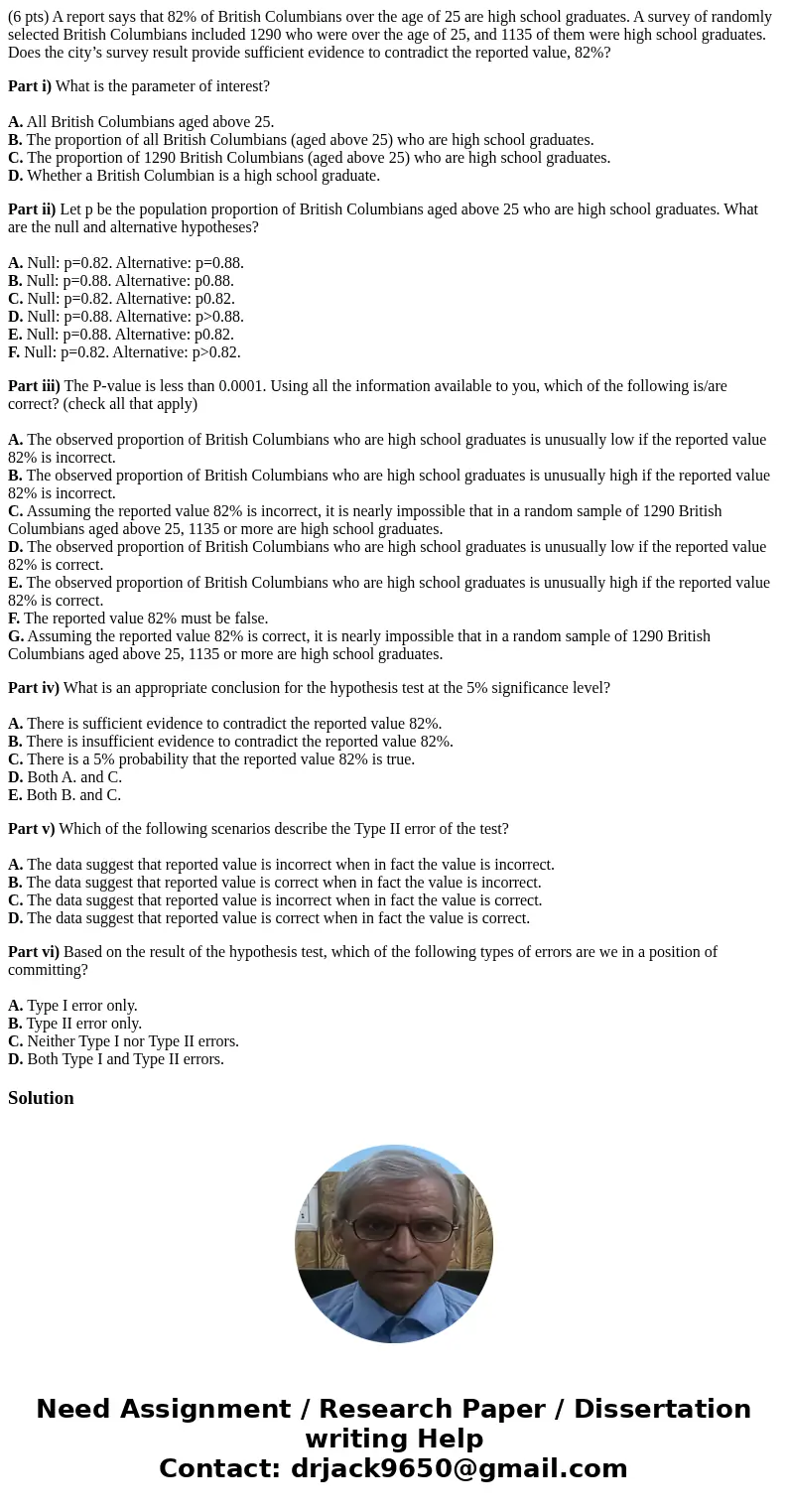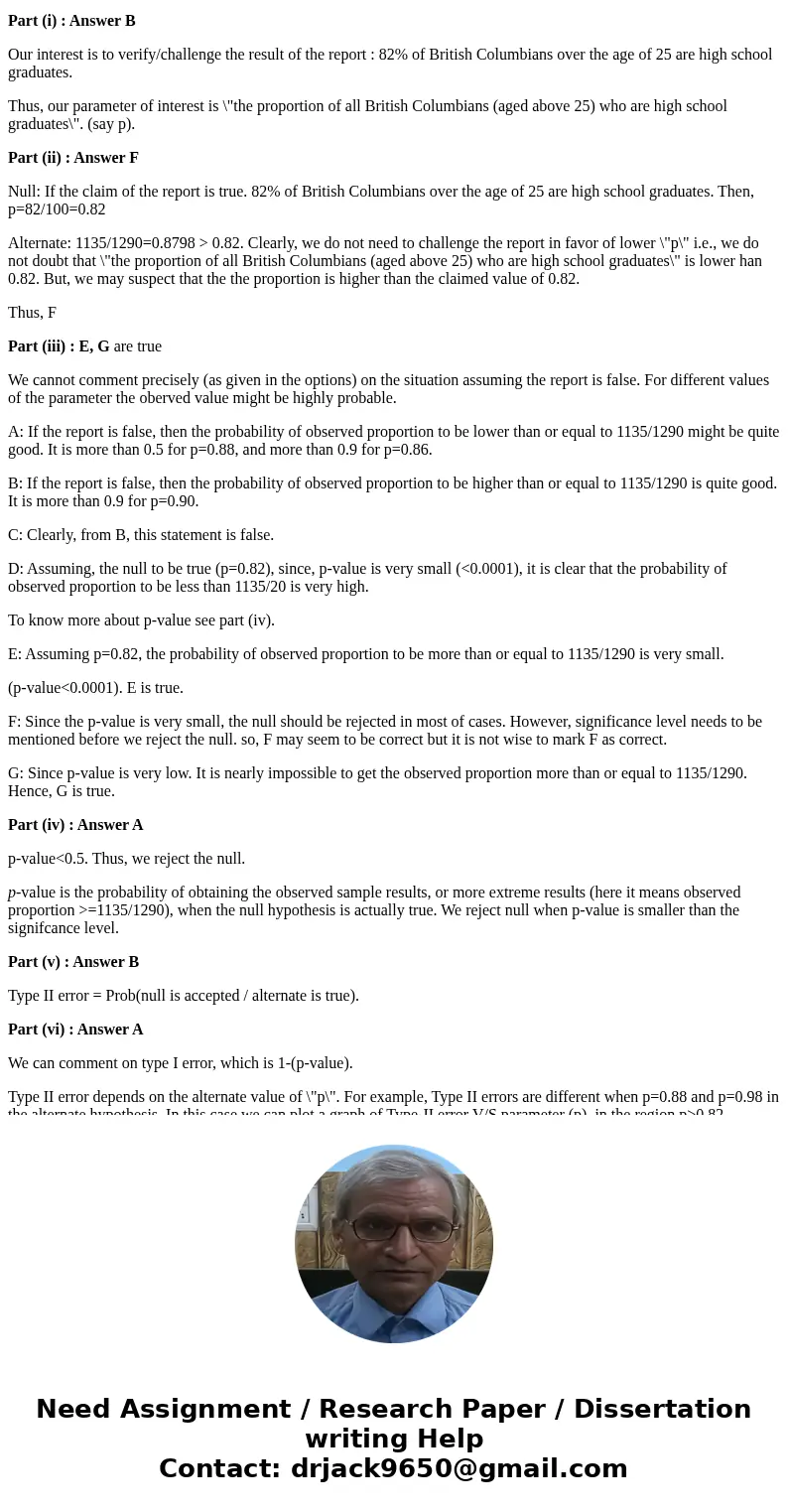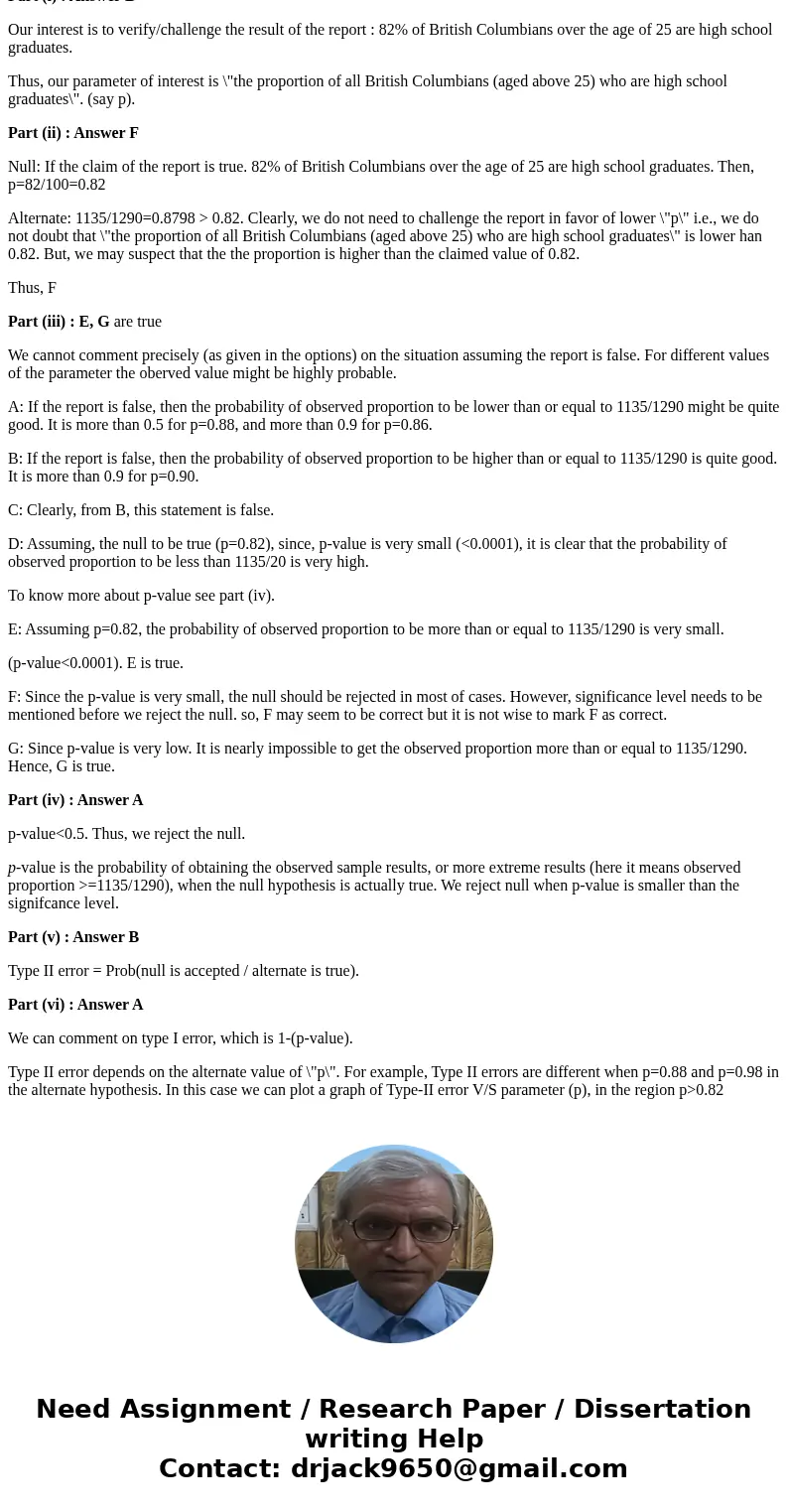6 pts A report says that 82 of British Columbians over the a
(6 pts) A report says that 82% of British Columbians over the age of 25 are high school graduates. A survey of randomly selected British Columbians included 1290 who were over the age of 25, and 1135 of them were high school graduates. Does the city’s survey result provide sufficient evidence to contradict the reported value, 82%?
Part i) What is the parameter of interest?
A. All British Columbians aged above 25.
B. The proportion of all British Columbians (aged above 25) who are high school graduates.
C. The proportion of 1290 British Columbians (aged above 25) who are high school graduates.
D. Whether a British Columbian is a high school graduate.
Part ii) Let p be the population proportion of British Columbians aged above 25 who are high school graduates. What are the null and alternative hypotheses?
A. Null: p=0.82. Alternative: p=0.88.
B. Null: p=0.88. Alternative: p0.88.
C. Null: p=0.82. Alternative: p0.82.
D. Null: p=0.88. Alternative: p>0.88.
E. Null: p=0.88. Alternative: p0.82.
F. Null: p=0.82. Alternative: p>0.82.
Part iii) The P-value is less than 0.0001. Using all the information available to you, which of the following is/are correct? (check all that apply)
A. The observed proportion of British Columbians who are high school graduates is unusually low if the reported value 82% is incorrect.
B. The observed proportion of British Columbians who are high school graduates is unusually high if the reported value 82% is incorrect.
C. Assuming the reported value 82% is incorrect, it is nearly impossible that in a random sample of 1290 British Columbians aged above 25, 1135 or more are high school graduates.
D. The observed proportion of British Columbians who are high school graduates is unusually low if the reported value 82% is correct.
E. The observed proportion of British Columbians who are high school graduates is unusually high if the reported value 82% is correct.
F. The reported value 82% must be false.
G. Assuming the reported value 82% is correct, it is nearly impossible that in a random sample of 1290 British Columbians aged above 25, 1135 or more are high school graduates.
Part iv) What is an appropriate conclusion for the hypothesis test at the 5% significance level?
A. There is sufficient evidence to contradict the reported value 82%.
B. There is insufficient evidence to contradict the reported value 82%.
C. There is a 5% probability that the reported value 82% is true.
D. Both A. and C.
E. Both B. and C.
Part v) Which of the following scenarios describe the Type II error of the test?
A. The data suggest that reported value is incorrect when in fact the value is incorrect.
B. The data suggest that reported value is correct when in fact the value is incorrect.
C. The data suggest that reported value is incorrect when in fact the value is correct.
D. The data suggest that reported value is correct when in fact the value is correct.
Part vi) Based on the result of the hypothesis test, which of the following types of errors are we in a position of committing?
A. Type I error only.
B. Type II error only.
C. Neither Type I nor Type II errors.
D. Both Type I and Type II errors.
Solution
Part (i) : Answer B
Our interest is to verify/challenge the result of the report : 82% of British Columbians over the age of 25 are high school graduates.
Thus, our parameter of interest is \"the proportion of all British Columbians (aged above 25) who are high school graduates\". (say p).
Part (ii) : Answer F
Null: If the claim of the report is true. 82% of British Columbians over the age of 25 are high school graduates. Then, p=82/100=0.82
Alternate: 1135/1290=0.8798 > 0.82. Clearly, we do not need to challenge the report in favor of lower \"p\" i.e., we do not doubt that \"the proportion of all British Columbians (aged above 25) who are high school graduates\" is lower han 0.82. But, we may suspect that the the proportion is higher than the claimed value of 0.82.
Thus, F
Part (iii) : E, G are true
We cannot comment precisely (as given in the options) on the situation assuming the report is false. For different values of the parameter the oberved value might be highly probable.
A: If the report is false, then the probability of observed proportion to be lower than or equal to 1135/1290 might be quite good. It is more than 0.5 for p=0.88, and more than 0.9 for p=0.86.
B: If the report is false, then the probability of observed proportion to be higher than or equal to 1135/1290 is quite good. It is more than 0.9 for p=0.90.
C: Clearly, from B, this statement is false.
D: Assuming, the null to be true (p=0.82), since, p-value is very small (<0.0001), it is clear that the probability of observed proportion to be less than 1135/20 is very high.
To know more about p-value see part (iv).
E: Assuming p=0.82, the probability of observed proportion to be more than or equal to 1135/1290 is very small.
(p-value<0.0001). E is true.
F: Since the p-value is very small, the null should be rejected in most of cases. However, significance level needs to be mentioned before we reject the null. so, F may seem to be correct but it is not wise to mark F as correct.
G: Since p-value is very low. It is nearly impossible to get the observed proportion more than or equal to 1135/1290. Hence, G is true.
Part (iv) : Answer A
p-value<0.5. Thus, we reject the null.
p-value is the probability of obtaining the observed sample results, or more extreme results (here it means observed proportion >=1135/1290), when the null hypothesis is actually true. We reject null when p-value is smaller than the signifcance level.
Part (v) : Answer B
Type II error = Prob(null is accepted / alternate is true).
Part (vi) : Answer A
We can comment on type I error, which is 1-(p-value).
Type II error depends on the alternate value of \"p\". For example, Type II errors are different when p=0.88 and p=0.98 in the alternate hypothesis. In this case we can plot a graph of Type-II error V/S parameter (p), in the region p>0.82



 Homework Sourse
Homework Sourse